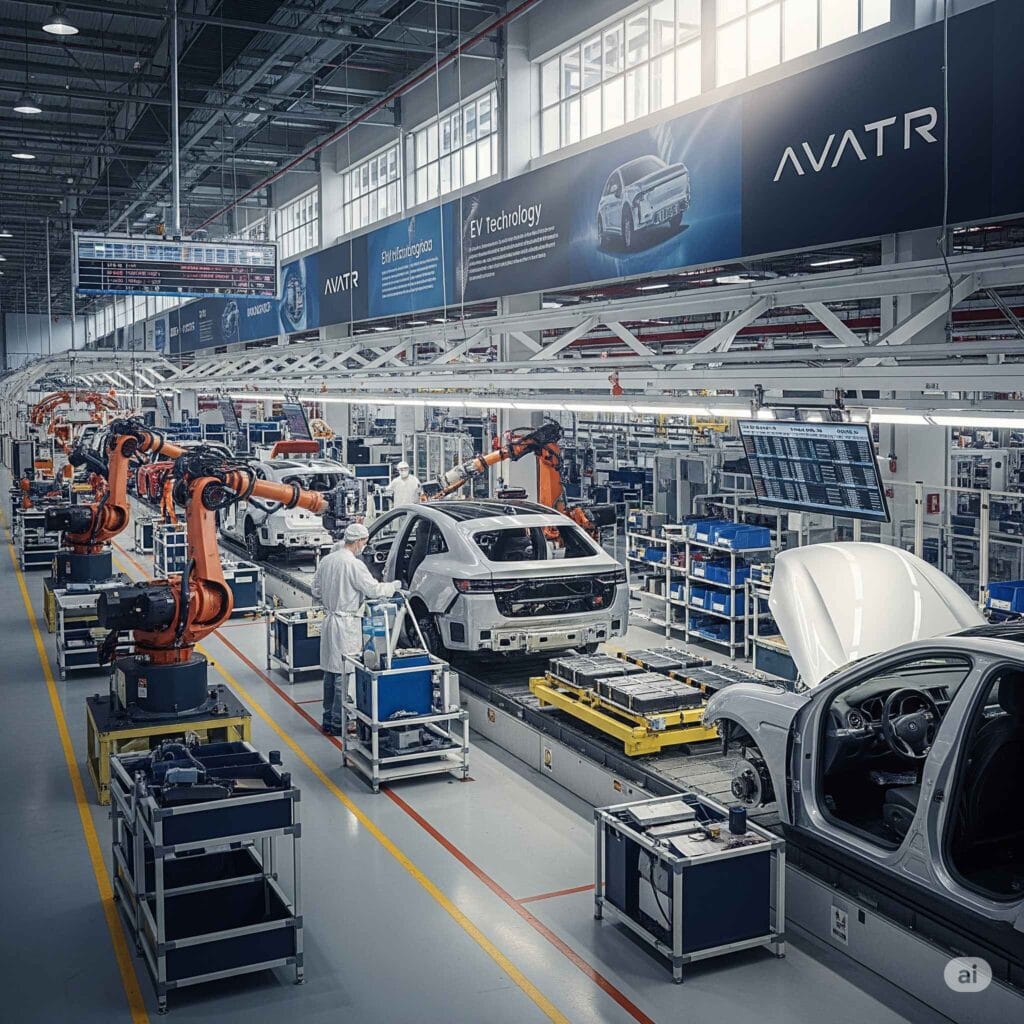Avatr EV factory is making headlines – a car every 60 seconds. That’s not a typo—it’s Avatr’s new manufacturing reality. In a world where production delays and long delivery timelines are frustratingly common, Avatr’s state-of-the-art factory in Chongqing is doing the exact opposite. It’s moving with robotic precision. Literally.

And while the speed is impressive, it’s not the whole story. What truly sets this moment apart is the tech partnership behind it. Avatr isn’t just building cars—it’s co-creating the future of smart vehicles with Huawei, the tech giant best known for smartphones, now shifting gears to revolutionize mobility.
Let’s break this down and see why this isn’t just cool—it’s critically important, especially for businesses and consumers who care about productivity, tech integration, and smart innovation.
Inside Avatr’s Ultra-Automated EV Factory(How the Avatr EV Factory Achieves One-Car-Per-Minute Production)
I remember visiting a car assembly line once—manual, noisy, slow. A car took hours, sometimes days, to finish. Now imagine this: Avatr’s factory produces a fully built, high-tech EV every 60 seconds. That’s 60 vehicles per hour, over 1,400 cars a day. In fact, by the end of 2024, Avatr had delivered over 73,606 vehicles, a massive jump from the 27,700 units it sold the year before (CNEVPost). Avatr EV factory

How is this possible? It comes down to a few key elements:
Fully integrated AI-driven robotics that operate with less than 0.1% margin of error
Sensor-based tracking systems for real-time part monitoring
Modular assembly units that reduce time between production phases
Unlike traditional production plants, where human involvement often slows down the process, Avatr’s facility is built for speed and precision. And because everything is optimized using data analytics, this factory doesn’t just produce faster—it learns and improves as it runs.
For companies managing fleet vehicles or startups aiming to scale with smart EVs, this means shorter delivery times, fewer errors, and predictable logistics. That’s a competitive edge.
The Power of Automation — How It Drives Efficiency
Let me paint you a picture.
A typical EV assembly line needs thousands of manual touches before a car is road-ready. Now imagine replacing 70% of those repetitive tasks with synchronized robotic systems. That’s not science fiction—it’s Avatr’s reality. Avatr EV factory
Here’s what this kind of automation brings to the table:
Consistency: Human error is nearly eliminated
Scalability: As demand rises, output can increase with minimal delay
Predictable Costs: Maintenance, power use, and labor costs are tightly managed
From a productivity standpoint, this is gold. Let’s say you’re in logistics and waiting months for new electric vans is slowing growth. With factories like Avatr’s, wait times could drop from 12 weeks to 3 weeks—a game-changer for last-mile delivery or rideshare businesses trying to scale with EVs.
In my opinion, this kind of fast, predictable production flow is going to become the standard—not the exception—in the EV space.
Avatr and Huawei’s HI Plus Partnership Explained
Now, let’s talk tech. Specifically, Huawei.While Huawei is known for phones and telecom, they’ve now entered the EV game in a big way. The latest version of their partnership with Avatr is called HI Plus. It’s not just a branding deal. It’s a full-on collaboration.
As of early 2025, Huawei has embedded over 300 R&D experts directly into Avatr’s product and design teams in Chongqing. That means engineers, UI designers, and software architects are working on:
HarmonyOS Cockpit Systems for responsive, smartphone-like dashboard interfaces
ADS 3.0 Driver Assistance which allows for lane centering, adaptive cruise, and smart parking
Full OTA (Over-the-Air) updates, making the vehicles smarter with every rollout
One of the Avatr staffers even shared in a local interview that “it’s not a car with smart tech—it’s a smart platform that happens to be a car.” That speaks volumes about the direction they’re headed.
This collaboration doesn’t just add cool features—it accelerates innovation. With Huawei’s agile development cycles, Avatr can test, update, and deploy new features in weeks, not quarters. Avatr EV factory
Flagship SUV Teaser — What We Know So Far
The factory is fast. The tech is smart. But what’s next?
Enter Avatr’s upcoming flagship SUV, teased heavily in late 2024 and expected to debut fully in Q3 2025. While the name isn’t final (some say it might be the Avatr 06), here’s what we know from verified sources like EVmagz:
Starting price: Approx. RMB 215,900 (~$30,000 USD)
Smart Features: Qiankun ADS 3.0, auto valet parking, multi-mode driver assist
Powertrain: Dual-motor 4WD with range estimates around 500–600km
Interior: HarmonyOS dashboard, ambient lighting, AI voice assistant
Crash-tested: Already passed a Euro NCAP 50% frontal collision test
Compared to Avatr 11 and 12, this SUV seems more compact but loaded with smart tech. For city drivers or smart family mobility, it could rival the likes of Tesla Model Y or the BYD Song L.
As someone who’s tracked EV trends closely, this is exactly the kind of launch that gets people upgrading—not because they need to, but because they want to.
Impacts on EV Industry and Business Productivity
Here’s where it all ties together: speed + scale + intelligence = productivity.
For the EV industry, Avatr’s factory sets a new benchmark. Traditional automakers with multi-month delivery times will need to rethink their systems. This model proves you can build faster without sacrificing safety, innovation, or cost control.
For businesses using EVs—like logistics fleets, ride-hailing services, or even rural mobility startups—this offers three major benefits:
1. Lower acquisition costs thanks to streamlined production
2. Faster fleet turnover, leading to lower maintenance and fuel costs
3. Future-proof tech that adapts to regulations, AI upgrades, and real-time analytics
And for the average consumer? It means smarter cars that get better with time, not worse. Avatr EV factory
Final Thoughts: Innovation Every 60 Seconds
Avatr’s factory isn’t just breaking speed records. It’s breaking old ways of thinking.
With automation on the production side and Huawei’s tech on the intelligence side, Avatr is building more than cars—they’re building a new standard for efficiency, productivity, and customer experience.
It’s the kind of innovation that makes you sit up and say: “This is it. This is where the future begins.”
If you’re a business decision-maker, an EV enthusiast, or someone just trying to understand what’s coming next—you’d be wise to keep Avatr on your radar. Because from what I’ve seen, the next revolution in smart mobility isn’t years away.It’s rolling off the line every 60 seconds. Avatr EV factory
Check out more on our homepage at FriendshipInfo – Home
How fast is Avatr’s new EV factory?
Avatr’s new automated facility can produce one electric vehicle every 60 seconds, thanks to advanced robotics and intelligent scheduling.
Is Huawei involved in Avatr’s flagship SUV?
Yes. Huawei is supplying the HarmonyOS cockpit, intelligent driving systems, and tech integrations for Avatr’s upcoming flagship SUV.
Where is the new Avatr factory located?
The factory is based in Chongqing, China, and it represents one of the most automated EV production sites in Asia.
What makes Avatr’s factory different?
The plant features 1,000+ intelligent robots, AI-powered logistics, and 100% automation in welding, paint, and assembly — resulting in higher precision and lower human error.
When is the new Avatr SUV launching?
Although no official date has been confirmed, the SUV co-developed with Huawei is expected to launch later in 2025.
Pingback: Oppo Find X9 Leak Reveals 200MP Camera, 7500mAh Battery, Dimensity 9500